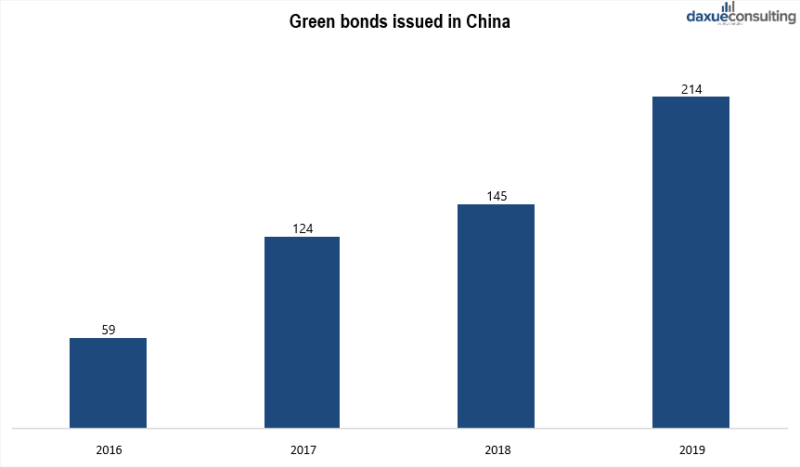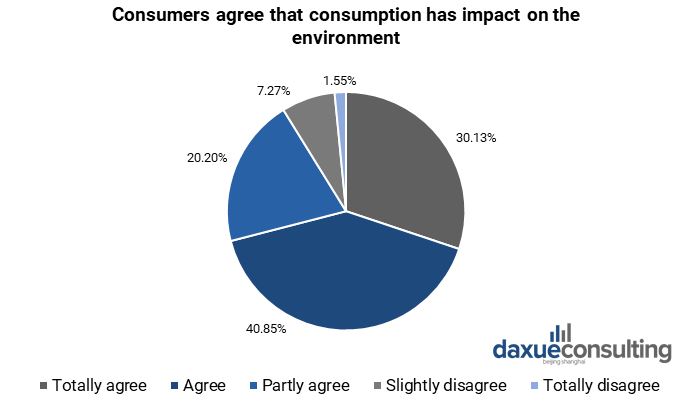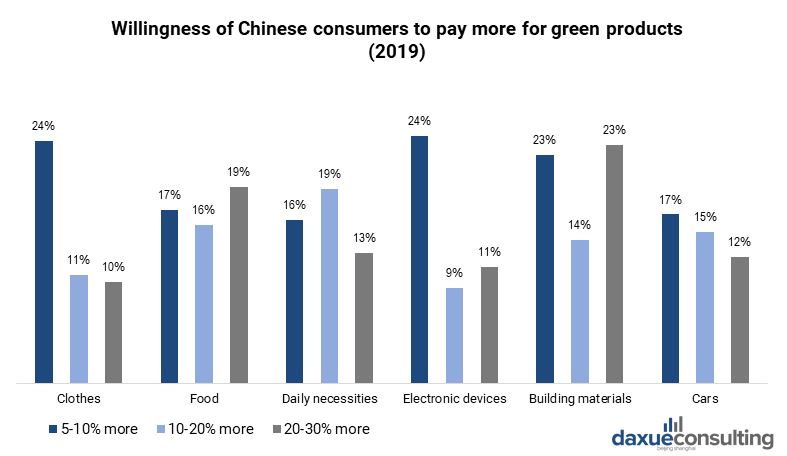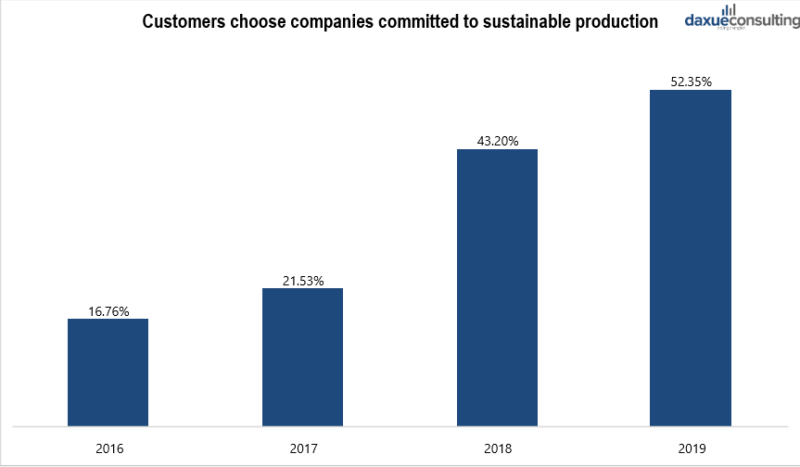Green products in China: Growing out of ‘Niche’ but needs more investment
Green products in China have become very successful in the past few years as the ‘green voice’ of citizens garners attention. Awareness of pollution and healthcare problems have transformed consumer’s habits significantly. Chinese markets are integrating this new pattern into their strategy and pay more attention to this global phenomenon, shifting towards green products at a very high pace.
Green products market in China driven by NGOs and the Government
The awareness of green consumption partly arises from the blooming of 3,500 environmental NGOs in China. For example, the NGO Friends of Nature is playing a major role and is precisely orientating consumers in choosing a green product, creating “blacklists” and developing concrete awareness actions. The other main force pushing the fast development of green products is the government. A first large action was undertaken in 2007, when the Communist Party Congress called for a change of all actors of Chinese companies to behave in a more environment-friendly way.
A year later, an environment protection ministry was created and has been producing measures to regulate unacceptable behaviors. Recently China defined clear targets enabling to overcome the challenge of maintaining at the same time such a remarkable rapid economy expansion and more eco-friendly industries. Matching policies promoting green products in China are being undertaken. It included subsidies for energy saving products and advantageous tax rates for low pollution vehicles.
Green products financing as national development strategy
According to China Chain Store & Franchise Association, government is a key stakeholder in promoting consumption of green products in China. Chinese government has strongly committed to promoting the transition to a green economy. In the past 15 years, China has included environmental protection within the national development strategy, promoting an ‘ecological civilization”.
Financing of green products market in China is one of the instruments for environmental changes. During the “13th Five-Year Plan” period (2016-2020) government improved the system of ecological projects financing, including support of green products. Green credits and green bonds are used to help the enterprises which produce eco-friendly products in China. Data show that in 2016, China’s green bond issuance accounted for 40% of the world’s total. In 2018, China’s green bond issuance exceeded 30 billion U.S. increased by 62% from the previous year. At the same time, from 2015 to 2018, China’s 21 major financial institutions issued more than $114 billion of green loans. In 2019 the People’s Bank of China announced the program of support of green enterprises by providing green debt financing instruments. Such government subsidies help to enhance market competitiveness of green products.

[Data source: Xinhua Finance ‘Green bonds issued in China 2016-2019’]
The role of environmental NGOs in China is growing
With the country’s increasing emphasis on environmental protection, various environmental NGOs have rapidly developed in China. The Chinese leadership is aware that the government cannot solve the serious environmental problems alone. The most important function of environmental NGOs is to increase environmental awareness among the population. Strengthening consumers awareness enhances their willingness to consume green products in China.
Recently political space in China has opened up for NGO to help government with environmental policies. Over the past decade, about 100 environmental non-governmental organizations have cropped up, not including the thousands of government-organized NGOs. Additionally, about 200 student environmental associations are active on college campuses.

[Data source: China Sustainable Consumption Research Program, ‘Most influential stakeholders in promoting green products consumption in China’, 2016]
Large preference for green products among consumers
Surveys over the market show the Chinese have learned to protect the environment by daily attention. The habit of saving water, food, and electricity is increasingly practiced in households. Easy and effective actions are undertaken with routine. However, this comes from the fact that the Chinese are purchasing green products in order to protect their own health and safety since scandals concerning the food and medical industry frequently occur. In 2017 survey showed that the environmental sustainability characteristic of a product was only ranked after personal health and safety. A perfect example to this statement is the French premium water, Evian that has been extremely successful those last years by branding themselves with health and purity regardless of the expenses and pollution of transportation.
However, from 2015 to 2017 the awareness of green labels increased from 78% to 89%. Additionally, the awareness of green products in China rose from 58% to 83%. In 2017 71% of respondents said they had been spending more on green products in the past year. According to the data released by the China Chain Store and Franchise Association, in recent years, the concept of green consumption has become increasingly trendy in the daily life of Chinese residents.

[Data source: China Sustainable Consumption Research Program, ‘Consumers agree that consumption has impact on the environment’, 2016]
Green products consumption is increasing, but still far behind the world average
Growing environmental concerns pushed consumers’ willingness to buy eco-friendly products in China. The appearance of online shopping platforms in recent years has seemingly helped to boost the consumption of sustainable products. Compared with the offline market, the number of merchants participating in the online market is bigger, which leads to a great variety of products. The online green products market in China is highly differentiated and consumers can easily switch among various products. For example, the biggest shopping platform in China, Alibaba, claimed that the number of consumers who do eco-friendly shopping has exceeded 380 million in the past years.
Besides, green products have been frequently searched on the Alibaba website. Searches for keywords such as formaldehyde-free, phosphorus-free, fluorine-free, and pollution-free all rose by more than 30%. According to JD online shopping platform, the overall sales of green products in 2019 increased by 18% from 2018. Such categories as food, beverage and homecare products grew faster, with growth rates of 195% and 90% respectively.
Green products in China’s FMCG markets
The food, beverages and apparel industries attract big amount of consumers in green products market in China. For example, consumers have gradually abandoned low-cost chemical fiber clothing from the perspective of environmental protection. They are more likely to choose cotton, linen, and silk materials, which are eco-friendly. At the same time, organic retail sales have increased from $4.712 million US in 2015 to $8.087 million US in 2018. Eco-friendly food has gradually become popular in the past two years, and consumers begun to prefer organic rice noodles and oils.
However, despite the fact that consumption of green products in China has increased much in recent years, the per capita consumption is still far behind the world average level. The reason is that green consumption concept started to take shape in China rather late and it requires intensified publicity and institutional promotion.
Growing demand for green products in China
The demand of consumers for various categories of green products in China has risen significantly, especially for food, beverages and homecare goods. 71% of consumers have increased spending on green products in 2016. In households with an income above 20,000RMB, that proportion increases to 76%. According to “China Sustainable Consumption Research Report” in 2017 about half of consumers were willing to pay 5-10% more for eco-friendly products in China, while in 2019, the number of such customers increased to 80%.

[Data source: China Sustainable Consumption Research Program, ‘Chinese consumers’ willingness to pay more for green products’, 2019]
Chinese millennials choose green products
Compared to their parents, millennials in China are more aware of social and environmental issues and care more about the impact of their actions on society. A survey showed that in 2017, 86% of millennials were interested in sustainable investment. Chinese millennials, especially in urban areas, are highly conscious of brands, quality, and value. They expect, like all young people around the world, to buy something that embodies their lifestyle choice. They expect the brands that they buy from to have an ethical stance both socially and environmentally. Eco-friendly shopping reflects their positive values: caring for the community, the planets, the animals, etc. JD.com’s research over 266 million customers in China showed that those aged 26-35 accounted more than half (51.8%) of the total volume of green purchases made on JD’s platform in 2017, and accounted for 48.8% of all users buying green products in China.
Consumers in first-tier cities are more likely to shop eco-friendly
In general, consumers in first-tier cities and second-tier cities have different perceptions of eco-friendly products in China. For Chinese people living in urban areas, safety and health were key priorities in choosing a product. Only interviewees in some first-tier cities actively mentioned that the production process of products should also pay attention to environmental protection. In addition to the understanding of the product’s safety and health, consumers in first-tier cities can be more connected with water conservation, recyclability, and environmental benefits. Studies show that as middle-income people predominate in first-tier cities, they are more likely to pay attention to the environment and choose eco-friendly shopping.
Companies go green to attract customers
The amount of people in China who choose the product because the manufacturer is well-known for fulfilling Corporate Social Responsibility commitments grew significantly. In 2017, consumers purchased only 21.53% of products for that reason, while in 2018, it accounted for 43.2%. In 2019, the proportion has reached 52.35%. As more and more people choose green products in China, enterprises start adopting eco-friendly strategies to increase brand loyalty. At present, China’s green manufacturing system mainly involves green factories, products, industrial parks and supply chains. In November 2018, the third batch of green manufacturing lists was released, featuring 391 green factories, 480 design products, 34 parks and 21 prominent supply-chain management enterprises. With the massive rise in fintech in China, companies such as Pintec or Ant Financial started providing microloans for small companies to “go green”.

[Data source: China Sustainable Consumption Research Program, ‘Customers choose companies committed to sustainable production’, 2019]
Emerging green strategies in Chinese companies
Some industries actively contribute to the development of green products market in China. For example, the fashion industry, which is currently the most polluting industry in the world, contributes to the development of green products. For companies in this industry, “sustainable development” is a powerful branding tool. That was the reason for record number of green manufacturers at the textile trade show in Shanghai in 2017. Green manufacturing is no longer the domain of specialist brands. For example, textiles giant Esquel, the world’s largest shirt maker, has put been putting sustainability at the center of its business. With sales of US$1.3 billion (8.5 billion yuan) in 2018, Esquel manufactures over 100 million garments annually for retailers including Marks & Spencer, Ralph Lauren, and Tommy Hilfiger, and has been focusing on building a more sustainable business for both staff and the environment.
Green products in China have high potential in the food industry. More than 11,000 enterprises have obtained more than 17,000 organic product certification certificates. Also, the number of registered organic marks has exceeded 1.7 billion. In the online food delivery industry, the unique example of eco-friendly strategy is Yikou company (full name, Yi Kou Liang Shi). This company uses only ceramic tableware for food delivery. After consumers finish their meals, Yikou collects cutlery and tableware to wash for reuse. The company’s innovative business model closes the loop on plastic in food delivery.
E-commerce giant Alibaba: example of successful eco-friendly strategy
Alibaba platform actively provides eco-friendly products in China, advocates green concepts, and encourages green actions. Gigantic scale of 11.11 shopping festival in China has huge impact on the environment. This caused by the packing materials used in the shipping of items. Cainiao, Alibaba’s logistics network, delivered more than 1 billion packages during 11.11 in 2018. Alibaba’s efficient logistics and accessible recycling programs are critical to reducing waste. Cainiao has introduced smart technology that improves packaging efficiency by 15%. In 2018, over 150 million eco-friendly packages were shipped without using any plastic tape.
In 2019 Alibaba established 40,000 stations along with additional 35,000 stations by its express delivery partners for recycling of packing materials. These stations act as collection and recycling centers for cardboard boxes and other packing materials returned by shoppers.

[Source: Alizila, ‘Shoppers bring their boxes and bags to a Cainiao recycling station’]
Additionally, the company plans to incentivize shoppers to return their packing materials to recycling stations by adding additional points in their Ant Forest app. This app is a green initiative by Alipay which allocates points to its users when they perform low-carbon activities in their daily lives. It includes cutting down the use of paper and plastic, paying their utility bills online, and using public transportation or bicycles instead of driving cars. Over 500 million consumers have activated this mini-app to track their low-carbon footprint through daily actions and have used their collective credits to plant more than 120 million trees in China.

[Source: Alizila, ‘Users click on an icon on the Alipay app to access “Ant Forest,” a game that rewards users who engage in activities with a low carbon footprint’].
Besides, in 2018, Alibaba provided hundreds of millions of environmentally friendly packaging for food delivery. Ele.me, the subsidiary of Alibaba, launched a no-cutlery option in their app for online food delivery. In 2019 they already accumulated 45 million orders from users who voluntarily chose not to use plastic cutlery.
Trend of “Buying Green” still looking for appropriate supply
Green products market in China is not yet overly competitive, and is limited to niche consumers. The market potential for organics and certified products can be expanded through increasing knowledge and trust. Sustainable standards and labelling are one of the effective measures, but they currently suffer from a lack of consumer awareness and recognition.
At the same time, there is currently a lack of supply of green products in China. In 2015 a gap of 44% was estimated since the demand for those goods is increasing very fast. In 2019 the development of green food cultivation and production technology in China was still relatively lagging behind, resulting in a slow growth of supply of organic food. At the same time demand continues to be much higher, what makes the gap between supply and demand in the market expand year by year. One of the reasons for that is lack of funds for green industry. In 2018, China’s total demand for green financial funds was 2.1 trillion yuan, but the total supply was 1.3 trillion yuan, and the gap between supply and demand was 0.8 trillion yuan.
China’s green products industry needs more investment
According to Xu Shufan, deputy head of the science, technology and standards department of the Environmental Protection Ministry China’s environmental protection industry can be reached fast, “but the industry still needs more investment from the market, rather than simply waiting for governmental investment”.
The research from 2018 showed that food and drinks were the most popular category among green products in China, followed by household cleaning products. Clothing and accessories were joint third in the list, along with personal care products. However, for the moment, many sectors are still waiting to awaken and set off with the population awareness concerning pollution and the global challenge of global warming.
Daxue Consulting can provide you support in entering the growing market of green products in China. We conduct all the market research and consulting services you may need, such as potential analysis, cost analysis, implementation feasibility etc. To know more about the Chinese green products market, do not hesitate to contact our dedicated project managers by email at dx@daxueconsulting.com.
Author: Valeriia Mikhailova
Let China Paradigm have a positive impact on your business!
Listen to China Paradigm on iTunes
















